Extended projects 2022 cohort
Click the links below to view each research project
- Saline performance of glass FRP bars
- Investigating the mechanical performance of an aligned discontinuous carbon fibre Nylon-12 composite towards more sustainable high-performance materials
- Chemical structure, thermal characteristics, and dynamic mechanical behaviour of castor oil-based polyurethane foams
- Assessing the environmental impacts of utilising timber within a wind turbine blade
- Local strengthening for Wrapped Tow Reinforced composite truss nodal joints
- Predicting the performance of sustainable composite materials in a range of manufacturing techniques
- The effects of stacking sequence on composite compressive performance and how to improve it
- Concept design of single and multi-rotor wind turbine support structures
- Biomimetic ionic liquid mediated plastic upcycling for the synthesis of functional inorganic materials
- Fracture toughness properties of high temperature composites
Saline performance of glass FRP bars
 Student: Asaad Biqai
Student: Asaad Biqai
Supervisors: Eleni Toumpanaki, Ian Hamerton, Manjola Caro
This research delved into the degradation behaviour of Glass Fiber Reinforced Polymer (FRP) bars and vinyl ester resin when subjected to saline environmental conditions, simulating harsh marine settings which will be faced by FRP reinforced concrete structures in saline ocean environments. Experimental assessments were meticulously carried out following the guidelines of ASTM D7617 to test FRP bars in transverse shear, ASTM D638 to test resin samples in tension, and dimensions were taken from ASTM D2344 to cast resin samples to be tested in short beam settings for shear properties. Testing encompassed three distinct intervals: initial measurements (time 0), evaluations after 15 days, and assessments after 30 days of exposure to the saline environment. Weight change of the samples was measured regularly to calculate the moisture uptake of the samples. The saline solution employed in the tests was composed of sodium chloride (NaCl) and sodium sulphate (Na2SO4), emulating salinity levels typical of oceanic environments but at a temperature of 50oC to accelerate the exposure conditions and environmental degradation effects.
The study unveiled that the initial phase of exposure led to substantial tensile strength degradation in resin samples, with further stabilization observed over an extended duration after the resin samples reached saturation as can be seen in Figure 1. An intriguing aspect of the research was the evident divergence between tensile and shear degradation profiles in the resin samples as can be seen in Figure 2 where the resin samples continued to degrade nearly linearly to an extended period of time even beyond the saturation of the resin samples.
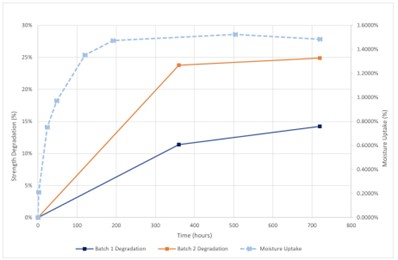
Figure 1 - Resin Tensile Strength Degradation vs Moisture Uptake
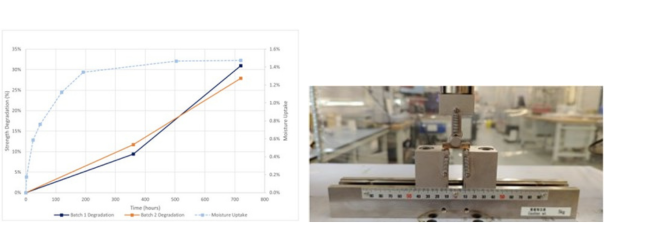
Figure 2 - Resin Shear Strength Degradation vs Moisture Uptake
Moreover, there was a notable alignment between shear degradation observed in resin samples and GFRP (Glass Fiber Reinforced Polymer) bars, implying that shear testing of resin samples may be a good representation of the material behaviour of GFRP bars under saline conditions as can be seen in Figure 3.
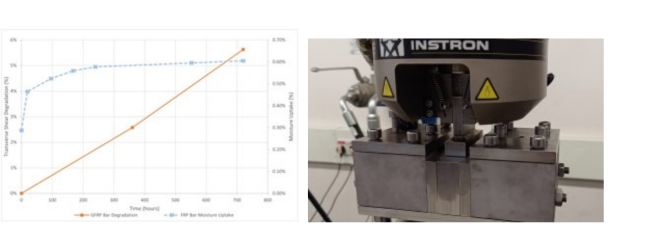
Figure 3 - GFRP Transverse Shear Strength Degradation vs Moisture Uptake
Furthermore, the research emphasized the critical role of moisture uptake during the initial exposure phase. Overall, these findings offer significant insights into the degradation dynamics of composite materials in saline environments, providing valuable implications for material engineering and the design of durable structures in challenging conditions.
Investigating the mechanical performance of an aligned discontinuous carbon fibre Nylon-12 composite towards more sustainable high-performance materials
 Student: Ragnar Birgisson
Student: Ragnar Birgisson
Supervisors: Ian Hamerton, Kate Robson Brown, Ben Woods, Tom Scott, Ali Kandemir
A composite material was made by combing 3mm aligned discontinuous carbon fibre preform made using the HiPerDif process with Nylon-12 thermoplastic. Impregnation was achieved through a two-step film-stacking approach. Due to a lack of suitable facilities, the samples were consolidated at a much greater pressure than desired. The high pressure and the unsuitable tooling design led to a significant squeeze-out of the material during consolidation, leaving only three viable specimens. Due to time restrictions, it was decided to continue mechanical testing regardless.
The material's observed mechanical performance was consistent in strain-to-failure and tensile stiffness. Strain-to-failure was in line with literature values, indicating good resin impregnation. However, the strength and stiffness of the material was underwhelming compared to previous work. Fibre volume fraction could not be confirmed in the timeframe but was expected to be low. A low fibre volume fraction may partly explain the underwhelming mechanical performance.
Another possible explanation for the mediocre mechanical performance could be seen in micrographs of the failure surface, which indicated fibre pull-out as the primary failure mode and moderate fibre disorientation. Efforts to promote higher strength failure modes through either longer fibres or modification of the fibre-matrix interface could improve material properties.
The viscosity of Nylon-12 at processing temperatures was confirmed to be on the order of 104 Pas. While this investigation indicates that the HiPerDif material can be effectively impregnated with thermoplastics of this viscosity, high-viscosity polymers such as PEEK may pose yet unforeseen challenges. Nevertheless, the results indicate that HiPerDif material is suitable for high-pressure moulding techniques if it can be confirmed that it is not significantly damaged during the process.
The significance of these conclusions is limited by the low number of specimens and the failure to verify the material's fibre volume fraction. Better data could be collected by redoing the experiment with bespoke tooling. Future work should include manufacturing the material with a closed mould designed for compression moulding, ideally with thinner nylon films to increase the volume fraction. In the future, a hot press with stricter pressure and temperature control would allow for better control of process variables.
Chemical structure, thermal characteristics, and dynamic mechanical behaviour of castor oil-based polyurethane foams
 Student: Jacopo Lavazza
Student: Jacopo Lavazza
Supervisors: Fabrizio Scarpa, Jemma Rowlandson, Charles de Kergariou, Qicheng Zhang, Wuge Briscoe
Rigid polyurethane foams (RPUFs) are among the most currently exploited polymeric materials thanks to their tailorable composition and properties. Driven by the ever-growing demand for more sustainable solutions, the industry recently began exploring greener polyol sources for synthesising RPUFs. Among these, castor oil has rapidly become one of the most successful alternatives. The current work investigates three RPUF formulations based on polyols and isocyanates derived from castor oil.
The chemical structure of the foams was analysed using Fourier-transform infrared spectroscopy, confirming the presence of characteristic transmissibility peaks corresponding to the polyurethane structure, demonstrating the successful synthesis of RPUFs using castor oil-based chemicals. The thermal behaviour was evaluated through thermogravimetric analysis, revealing that the castor oil-based RPUFs' thermal stability was comparable to petroleum-based products; whilst differential scanning calorimetry showed two distinct glass transition temperatures associated with the presence of both hard and soft segments. Drop impact tests, performed through a custom-built test rig, revealed the strongly elastic response of the foams, which suggests the need for higher impact energy in future tests to fully explore the material response. Finally, vibration transmissibility tests, performed through a bespoke test rig, were used to investigate dynamic stiffness and loss factor of the three RPUFs, confirming their predominantly elastic character.
The thermo-chemical investigation revealed that the three formulations presented similar characteristics. Concurrently, they showed consistent differences in their dynamic mechanical response, attributable to the different cellular morphology obtained by varying the foam chemical formulation.
Assessing the environmental impacts of utilising timber within a wind turbine blade
 Student: Matthew Leeder
Student: Matthew Leeder
Supervisors: Neha Chandarana, Steve Eichhorn, James Norman, Eleni Toumpanaki
Using timber within the construction of wind turbine blades has the potential to reduce the latter’s environmental impact, aiding efforts towards Net-Zero targets. However, the recent interest in designing timber turbine blades has not yet been met with an adequate assessment of the resultant environmental impacts. In this study, a consequential life cycle assessment was conducted to assess the environmental impacts of replacing the majority of the glass fibre composite, in a 5 MW reference wind turbine blade, with wood epoxy composite. The substitution was found to reduce the blade’s impact score by only 3.9%, due to the overshadowing impact of the CFRP reinforcement within the blade. Along with reducing the use of virgin CFRP, possible improvements were identified as using locally sourced timber and promoting forest expansion to respond to an increase in timber demand. This study is the first step in assessing the sustainability of constructing wind turbine blades from timber. Further work is needed however in both the life cycle assessment and the structural modelling for a decisive assessment.
Local strengthening for Wrapped Tow Reinforced composite truss nodal joints
 Student: Matthew Lillywhite
Student: Matthew Lillywhite
Supervisors: Ben Woods, Terence Macquart, Eric Kim
An identified failure mode of Wrapped Tow Reinforced (WrapToR) Structures is debonding at the nodal joints of the truss. In order to improve performance of WrapToR trusses, nodal joints need to be strengthened to delay onset of failure in these areas. To this end, relevant and existing truss strengthening methods are explored and two external strengthening methods have been developed, a composite wrapping and a metal clip. Characterisation of joint performance was attempted by development of a bespoke test method, which was ultimately unsuccessful in producing relevant data for the strengthened joints, but there are indications of successful strengthening. Comparisons of the strengthening methods are made primarily through the added mass of the designs and qualitative insights from manufacture. In the tests performed some further insight into factors that effect WrapToR joint strength were found. This work concludes that of the two methods, the composite wrap is a superior design, but requires validation to determine the true failure load and structural efficiency. Follow on work with the purpose of furthering the development of these designs is considered and suggested.
Predicting the performance of sustainable composite materials in a range of manufacturing techniques
 Student: William Mahoney
Student: William Mahoney
Supervisors: Karthik Ram Ramakrishnan, Neha Chandarana, Ian Hamerton
Recycled carbon fibre (rCF) composites are a valuable solution for helping industries such as aerospace and automotive move towards a more closed-loop manufacturing model. The recyclates are more often than not downcycled into components that do not require the same load-bearing capabilities as virgin carbon fibre (vCF) materials. This is because most recycled materials are discontinuous randomly oriented mats and therefore do not possess anisotropic mechanical properties or high fibre volume fractions. There is a need to investigate the uses of rCF composites for structural applications to highlight where the limiting factors exist in terms of mechanical properties. Future research can then better target and improve the areas where rCF materials lack.
Though the typical fibre architecture of rCF fabrics may not be suitable for use in structural applications, they may lend themselves to improve the fracture toughness of these structures as interleaving plies or additional toughening in filler materials. An application where it may be feasible to use rCF materials is as the filler material within a stiffened composite panel, such as a T-joint stiffener. Where the radius of the stiffening-web laminate meets the skin it is required to use additional resin or adhesive to fill the area, to decrease the stress concentration of the structure. The filler material of the joint, though important, is not necessarily critical to the success of the stiffener. What is more important, is the interlaminar fracture toughness of the filler and the toughness between the filler and skin/web. Delamination of the filler/web or filler/skin interface is one of the most common failure modes of the stiffener, this delamination is initiated by mode I and II fracture mechanisms that induce premature cracking within the delta filler.
Therefore, this research aimed to characterise the toughening capabilities of realigned rCF systems and compare them to the current vCF filler materials to evaluate the changes in properties. Then the two dissimilar fibre architectures will be consolidated in a single laminate to evaluate the crack propagation characteristics. The mechanical tests that were used in this research were double cantilever beam (DCB) and end-notched flexure (ENF). The results of this work found that the rCF specimens showed improved mode I and II interlaminar fracture toughness against vCF and r+vCF specimens due to the extent of fibre bridging between neighbouring plies during manufacturing. The fibre bridging was a major interply crack arrestor and almost entirely stopped the expected delamination in both the DCB and ENF testing modes. Though the failure load was lower, the effect of having rCF and vCF fibre architecture laid up next to each other only decreased the mode II fracture toughness by 8.2%. Future work should look to study the elastic modulus vs. fracture toughness ‘tradeoff’ between rCF and vCF to establish whether fracture toughness alone is the most important factor when designing a T-joint stiffener.
This project is supported by GKN Aerospace.
The effects of stacking sequence on composite compressive performance and how to improve it
 Student: Joe Rifai
Student: Joe Rifai
Supervisors: Michael Wisnom, Giuliano Allegri, Xun Wu, Laura Pickard, Richard Trask
The aim of this research project is to experimentally investigate the effects of the stacking sequence on the compressive performance of composites. The effects of the stacking sequences of composites have been neglected. Composite manufacturers follow standard laminate configurations to obtain the desired extensional [A] stiffness. A flexural test was designed at the University of Bristol to obtain compressive strain results which exceeded the results reported by the manufacturer. The test shows consistency and repeatability of test results indicating a suitable test method to obtain compressive failure. A sandwich structure was designed and manufactured to expose compression failure within the gauge section. Experimental procedures in accordance with ASTM D5467 were used to obtain the compressive performance of IM7/8552 unidirectional carbon fibre with different stacking sequences of cross-ply and quasi-isotropic laminate.
Early results of the quasi-isotropic laminate indicate that the placement of highly loaded fibres further away from the symmetry shows slight improvements in longitudinal bending stiffness. However, in the cross-ply arrangement, opposite results were noticed. The use of 90° fibres supports the 0° fibres from splitting due to cross-bracing. The cross-ply configuration appears to show that the placement of the 90° fibres further away from the laminate’s symmetry increases transverse bending stiffness and may suppress the 0° fibres during compression. Experimental results and SEM scans show specimen results and post-failure mode. This suggests that the stacking sequence can be used to support highly loaded fibres in compression. Further work will focus on the further improvement of the compressive performance of composites by suppressing highly loaded fibres from kinking and reviewing the architecture of our composite materials to improve longitudinal stiffness. This work is aligned with NextCOMP’s research programme objectives to develop the next generation of composite materials with improved compressive performance.
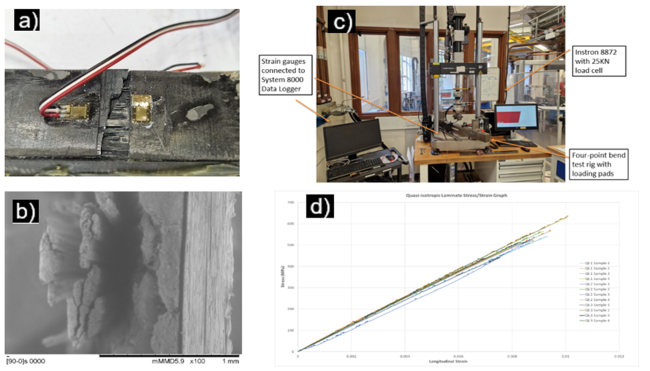
Figure 1: (a) Cross-ply failed sample exposing 0° plies. (b) Cross-sectional view of cross ply sample showing delamination of 0° plies due to fibre instability. (c) Test setup in accordance with ASTM D5467 test standards. (d) Consistency and repeatability of results obtained for quasi-isotropic samples.
Concept design of single and multi-rotor wind turbine support structures
 Student: Gokhan Sancak
Student: Gokhan Sancak
Supervisors: Terence Macquart and Alberto Pirrera
The preliminary design of wind turbines is an exploratory design phase which helps researchers understand the benefits and drawbacks of different configurations and improve the performance of various wind turbine systems. In accordance with the DTU 10MW reference wind turbine, dimensions for the support structure for single and multi-rotor systems are determined and modelled in MATLAB. After dimensioning the tower and space frame that is the structure connecting the rotor nacelle assembly (RNA) to the tower, the diameters and the wall thicknesses are determined by optimisation based on two failure criteria, von Mises and buckling strength. The aim of this study is to investigate the dynamic response and the total mass of modelled configurations. A comparison between the single-rotor model, and the multi-rotor models of tri-rotor and hepta-rotor is presented. Figure 1 illustrates the finite element (FE) representations of two of the modelled configurations and the body displacement of 20-fold scaled up in the z-axis after the introduced loads i.e., thrust and mass.
After optimizing the thicknesses and the diameters of each component of the structures i.e., tower, arms, RNA and frame bars, a normalized mass distribution is plotted and can be seen in Figure 2. It is seen that the open frame configurations have shown an increase in mass whereas closed frame configurations reduced the mass in general. For example, the mass of the open-frame hepta-rotor configuration is 15% higher than that of the single-rotor model. By contrast, the closed frame hepta-rotor showcases a 2.7% reduction in mass. The current results indicate that using frame bars connecting the arms and rotors to one another, as well as constraining the space frame to the tower, improves structural efficiency, resulting in an overall reduction of mass for the closed-frame multi-rotors.
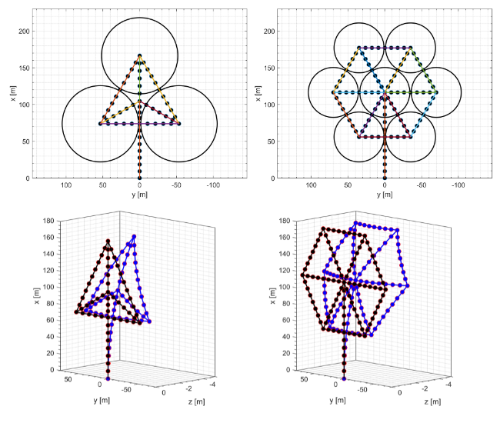
Figure 1: (a-b) FE representation of multi-rotors, (c-d) Displacement of the support structures; a, c) Closed Frame Tri-Rotor (CFTR), b, d ) Closed Frame Hepta-Rotor (CFHR).
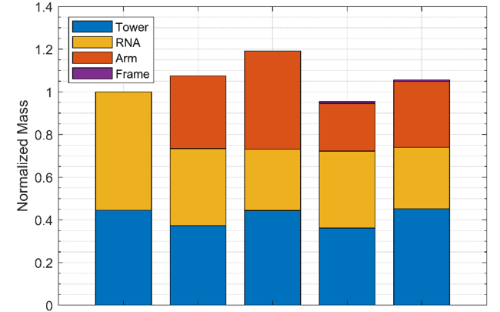
Figure 2: FE representation of multi-rotors, a) Single Rotor (SR),b) Open Frame Tri-Rotor (OFTR), c) Open Frame Hepta-Rotor (OFHR), d) Closed Frame Tri-Rotor (CFTR), e) Closed Frame Hepta-Rotor (CFHR).
Biomimetic ionic liquid mediated plastic upcycling for the synthesis of functional inorganic materials
 Student: Jan Maurycy Uszko
Student: Jan Maurycy Uszko
Supervisors: Simon Hall, Avinash Patil, Steve Eichhorn
Biobased materials are commonly used. Even if they originate from biobased feedstock, the utilisation or recycling still might be problematic. This project investigates if the method of upcycling cellulose to high-value functional inorganic materials can be transferred to cellulose acetate cigarette filters, most littered man-made objects on the planet, and to a Symbiotic Culture of Bacteria and Yeasts (SCOBY), a side product of Kombucha production. This could be achieved by using ionic liquids (ILs), novel, green solvents with low vapour pressure and high ionic conductivity. ILs can facilitate the dissolution of metal salts and plastic waste. It was illustrated that unlike SCOBY, cellulose acetate can not be used for synthesizing phase pure Ytrium Barium Copper Oxide (YBCO) superconductor, but the use of IL allows for the synthesis of Y2Cu2O5 pigment. Results were confirmed by powder X-ray diffraction (XRD) and superconducting quantum interference device analysis(SQUID).
Fracture toughness properties of high temperature composites
 Student: Anna Williams
Student: Anna Williams
Supervisors: Giuliano Allegri and Ian Hamerton
Delamination, the separation of layers, is the primary failure mechanism within composites. Fracture toughness is a measure of a material’s resistance to delamination, and therefore of great concern when designing composite structures. As composite materials are employed within higher temperature applications, especially in the aerospace industry, it is important to understand how they will react in elevated temperatures. Whilst standards exist for establishing fracture toughness properties at room temperature, there is no universal standard for testing at elevated temperatures, therefore, this research project was conducted to gain familiarity with testing at elevated temperatures, and to obtain benchmark data from an established organic composite material.
A leading aerospace-grade epoxy-based composite material, IM7-8552, was selected for testing as it is readily available, widely used, and is currently employed in high temperature applications. The work produced in this project characterised and recorded the Mode I fracture toughness properties of IM7-8552 in room temperature conditions and at elevated temperatures, representative of heat conditions experienced in aerospace applications. The morphology of the tested specimens was studied to compare and contrast the fracture surfaces between the two temperatures, and to give a greater insight as to how damage initiates and propagates within this material. This study has set a baseline standard of quantitative properties and qualitative fracture features for performance comparison with newly developed high-temperature resin matrix composite materials. Figure 1 shows the utilised test set up and Figure 2 shows SEM images of representative fractured specimens.
During the project, a few of the difficulties and adaptations of testing at high temperatures came to light, including visibility limitations interfering with tracking the crack propagation as the specimen delaminated. These insights made way for the initial planning and development of mitigating strategies to allow testing to continue with confidence and reliability at elevated temperatures.
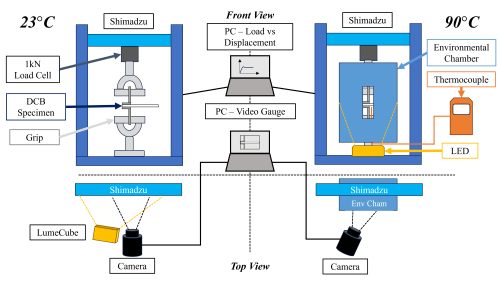
Figure 1 - Test set up for DCB testing at 23°C and 90°C

Figure 2 - SEM Images of the fractured surfaces of specimens tested at 23°C and 90°C